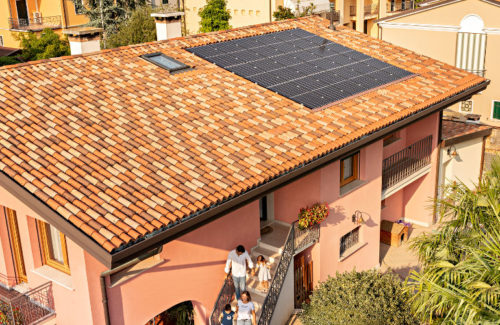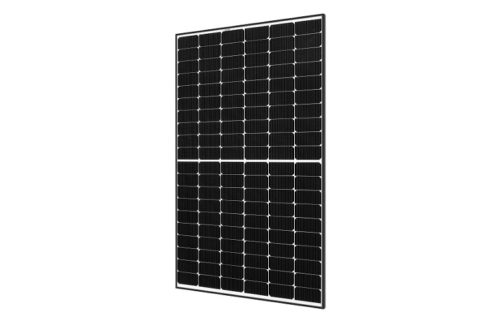Solar panels using larger wafers has been the big trend for 2020 and will change the market going forward in many ways — racking systems, design software and installation techniques will all have to adapt to differing solar panel sizes. These changes are more easily made in the utility-scale market, and that’s why large format panels are unlikely to hit rooftops any time soon.
We talked with solar panel manufacturer REC about the company’s plans for wafer updates. The company focuses on the residential and commercial rooftop markets and has in-house solar cell manufacturing, so REC isn’t diving in to large-format modules yet, but it is exploring its options. The following is our conversation with Cary Hayes, president of the Americas at REC Group.
REC hasn’t moved in to larger wafers like other companies. What are your thoughts on that trend?
 There is a shift to larger wafers taking place, but the transition is much more pronounced in the utility segment than it is in the rooftop segment, which is the focus of REC. That said, we are starting to see larger wafers in the rooftop segment as well. The benefits of moving to larger wafers (and a correspondingly larger module) are compelling in the utility space. A larger module will typically require fewer balance of system components and less labor to install than an equivalently sized system built with a smaller module. This lowers capex which drives down the LCOE.
There is a shift to larger wafers taking place, but the transition is much more pronounced in the utility segment than it is in the rooftop segment, which is the focus of REC. That said, we are starting to see larger wafers in the rooftop segment as well. The benefits of moving to larger wafers (and a correspondingly larger module) are compelling in the utility space. A larger module will typically require fewer balance of system components and less labor to install than an equivalently sized system built with a smaller module. This lowers capex which drives down the LCOE.
In the rooftop segment, particularly for residential installations, the benefits are less clear. If the benefits of installing larger modules on residential rooftops were as clear as they are in the utility segment, we probably would have already seen a shift to 72-cell modules in this market. We haven’t, which tells you that a larger sized module is not the holy grail for residential installers.
REC surveyed our customers about their module size preferences earlier in 2020. In the utility and C&I space there was a clear preference for larger modules. For residential installers, the preference was not as strong and there were a lot more concerns about handling and the weight of larger modules. Another concern raised by some installers was that on many hip and valley roofs, installers sometimes need to be able to fit modules in tight spaces where larger modules can present a problem. However, because many customers are attracted to modules with higher nameplate power, most installers understand that the move to larger modules is inevitable in the residential segment. So far, we have seen manufacturers do this with larger wafers but also with 66-cell modules. In the U.S. market, we have not yet seen too many products with wafer sizes that are larger than M6 in size, so that seems to be the limit for now in this segment.
Does REC plan on moving to larger wafers eventually?
REC does in fact sell some products with larger wafers already. Traditionally we made everything on an M2 wafer but in the last year or so we have started to sell products made with G1 and M4 wafers, which are larger. We have not yet manufactured a product with an M6 wafer, but we can and will do this if that is what our customers demand.
Does REC depend on other suppliers for cells, and therefore will have to swap to different sizes if that is what is supplied?
No, REC manufactures its own cells. Our flagship product – Alpha – is made using a highly specialized HJT cell that we manufacture in-house and whose production cannot be outsourced. The same is true of the cells we manufacture for our N-Peak product line.
Does REC’s use of heterojunction technology negate the need to change to larger wafers for improved power?
The rapid decline in the cost of solar PV has been made possible mainly by improvements in cell efficiency as this is the most effective way to drive down costs. Increasing cell efficiency allows you to install more watts per square meter and for a given system size this means you need less silicon, silver, glass, aluminum, copper, steel and labor to deliver the same number of watts. The result is lower costs. Larger wafer products offer some BOS and labor savings benefits, but they do not increase the number of watts that can be delivered per square meter of a solar PV installation and therefore do not drive down costs as efficiently.
REC believes that we can deliver the most value to our end-customers by offering them high-efficiency products. This is the reason why we have invested in the production of an HJT product, Alpha, that has very high cell (and module) efficiencies. To some extent, this does negate the need to move to larger wafers as our high-efficiency products have high nameplate power. That said, we are flexible and responsive to what the market demands. If we believe that our customers want an even higher nameplate product that we can make using larger wafers or by increasing the number of cells per module, we will certainly consider doing this.
What does REC view as important beginning in 2021?
In the United States, the steps that the Biden Administration takes to tackle the climate challenge will have enormous implications for our industry. Much will depend on what the Administration is able to get passed through Congress, but it is fair to say that we expect significant solar PV growth in 2021 under a Biden Administration. This growth is likely to come from an extension of the federal ITC for solar PV as well as increased federal procurement of solar PV.
The Administration has also made investment in clean energy R&D a priority and while this might not manifest in higher PV growth in 2021, it will be beneficial for solar PV in the years to come. We are also keeping an eye on state actions to stimulate job growth in their states, much of which we expect to have a green or clean focus.
Globally, we are expecting the same in most solar PV markets. Coming out of the COVID crisis, we expect many countries to stimulate their economies to spark growth and much of this stimulus will been green or clean. This can only be good for solar PV demand.






Great on new technology, I hope to see more development on solar components.